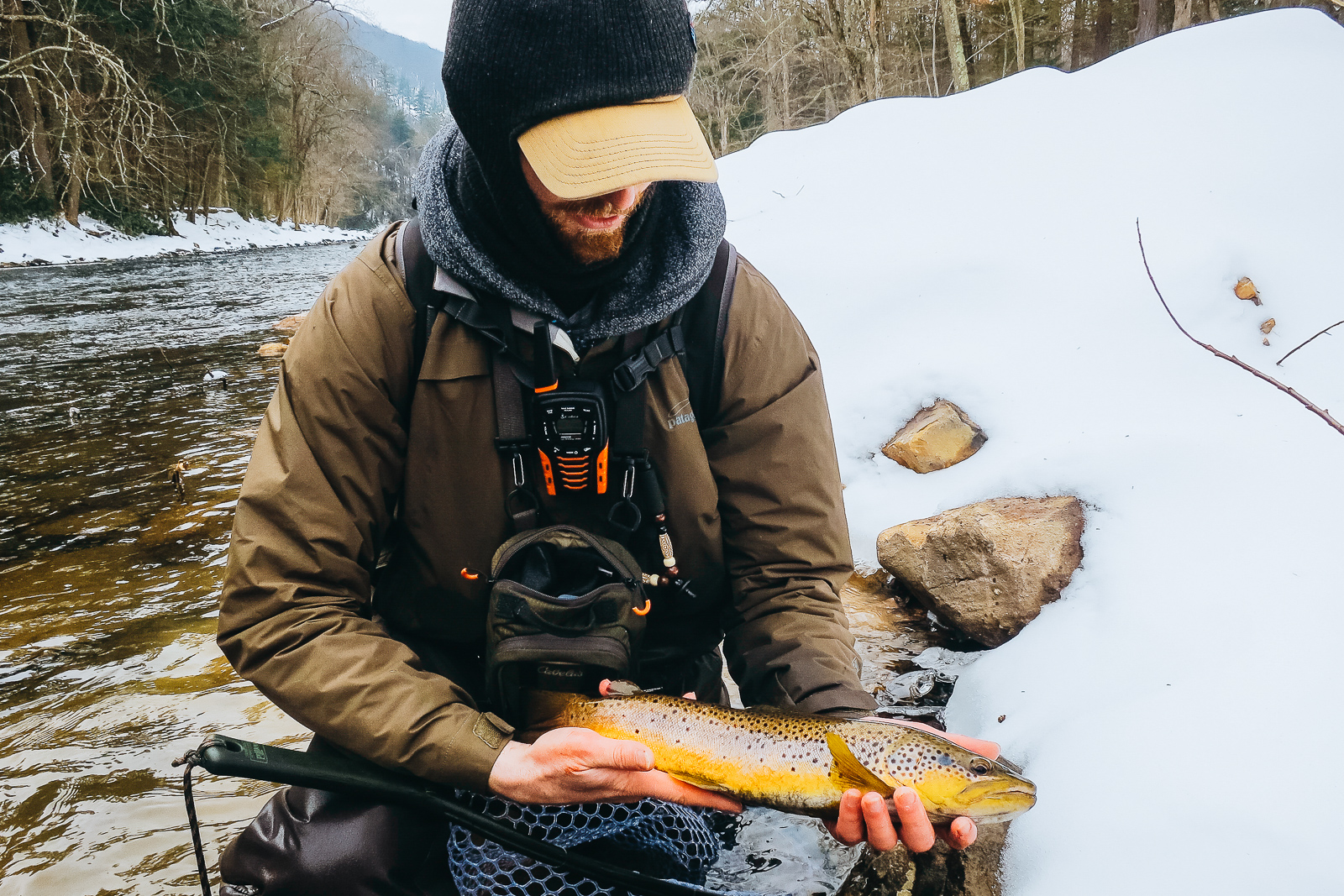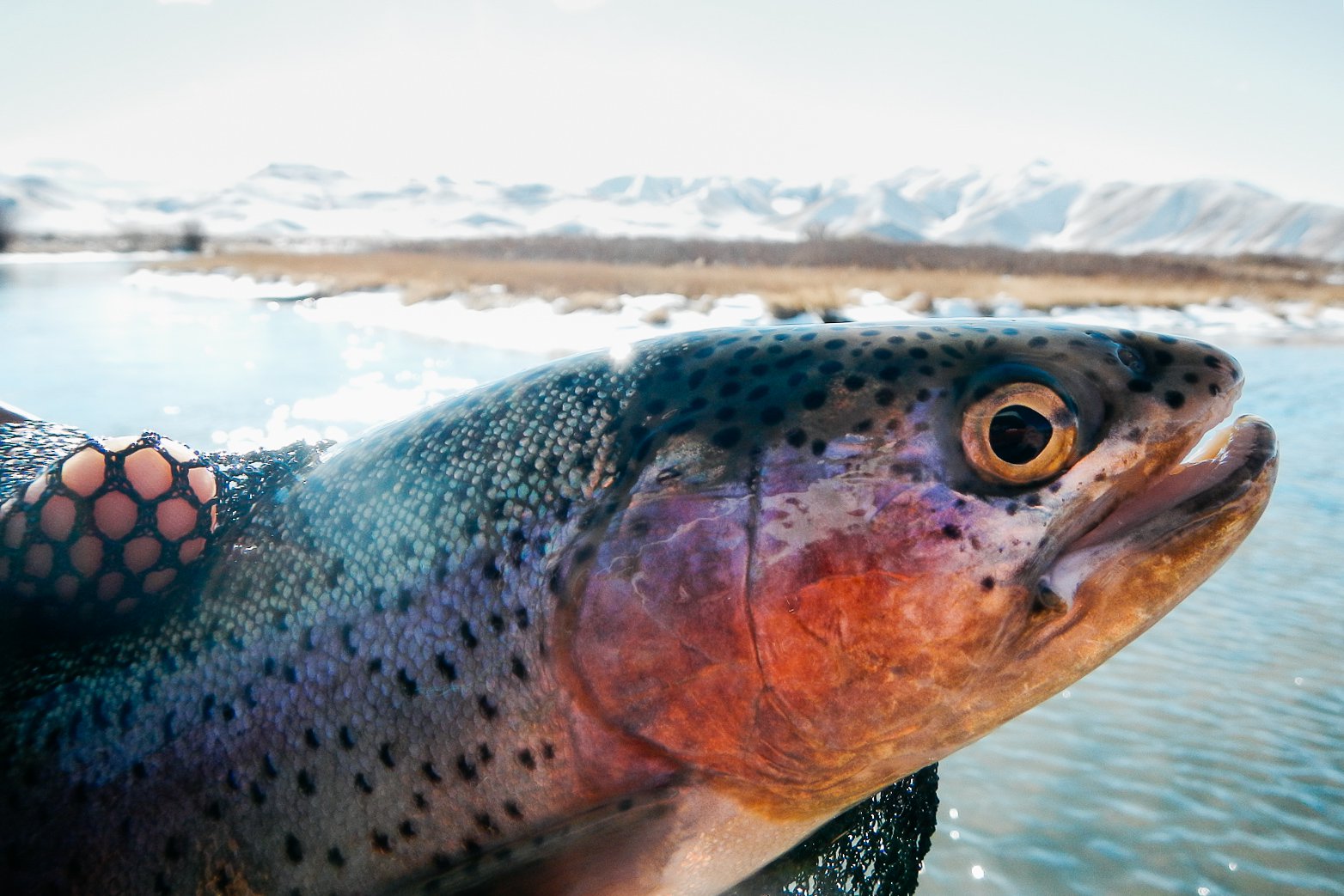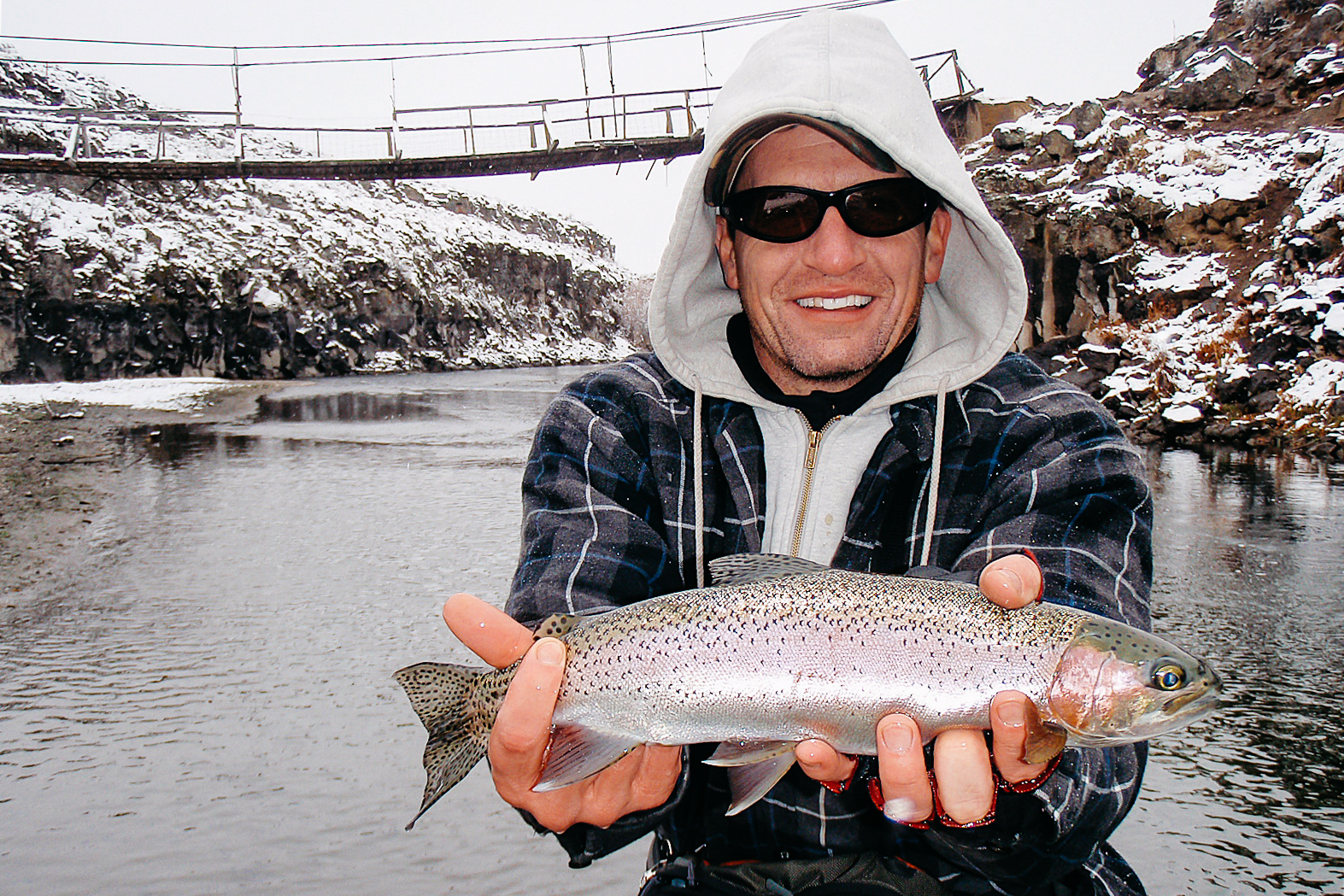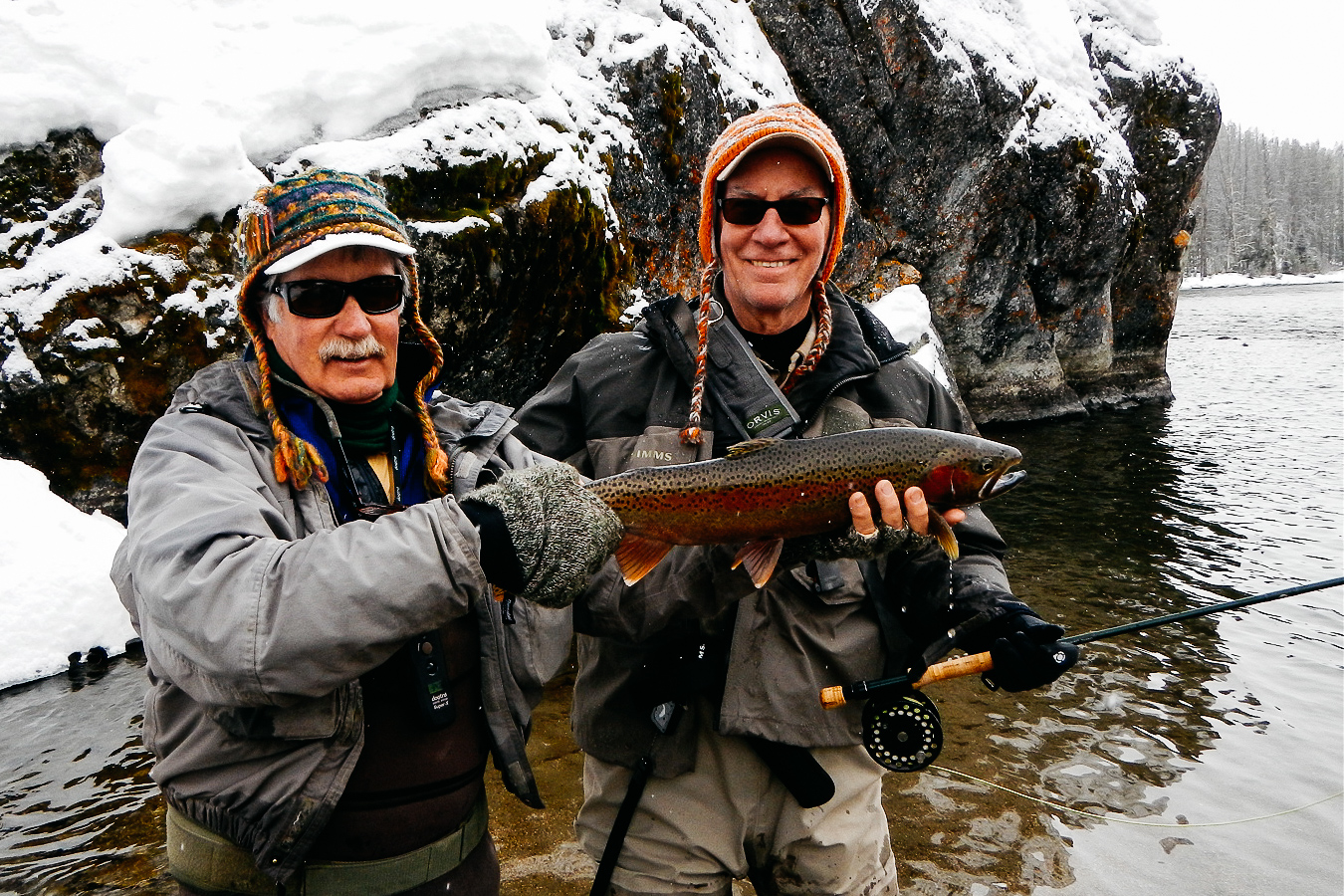There’s Fly Fishing in the Winter?
I’ll admit that winter fly fishing isn’t for everyone. Even some of the best and most die-hard anglers I know won’t touch a fly rod all winter long. They find the idea of fly fishing on ski days to be darn near demented. While these fair-weather anglers certainly have their own virtues, in the eyes of us year-round fishers, they’re being a bit foolish. Sure, the warm-weather anglers will reply, calls us want you want but at least we’re not dumb enough to go fly fishing when it’s freezing out!
Having our intelligence (or sanity) questioned is one of the downsides for us winter fly fishers, although most of us don’t mind. While some winter days can be magical, others are filled with all the other frustrations fishing can bring—only it’s colder and your eyelets freeze over. On those days it can seem a little bit nuts to be standing in the middle of an icy river when your favorite place to grab a warm cup of coffee or cold brew is just a short drive away. But as they say, any day on the river beats a decent day at work, even if the river banks are covered in snow.

Matthew Steinwurtzel is one of those year-round anglers who has fallen in love with winter fishing on the Big Wood River. Originally from Maryland, when Matt is not at work at the Wood River Land Trust he can usually be founding chasing after trout regardless of what the weather is doing.
“My favorite part about fishing in the winter is, given the appropriate clothing, knowledge, and determination, an angler can often achieve a sense of solace that would typically only be found in the backcountry,” he explained. “The quietness of the season and the experiences it can bring are unlike any other time of the year. “
For those of us brave, slightly crazy and over-dressed folks who like to fly fish in the winter, it’s pretty tough to top Sun Valley. To help you make the most out of it, here are a handful winter fly fishing tips.
1. Things Have to Have
A fishing license is actually more import to have than a rod. You can’t get in trouble for only having a license in your hand. You can pick up licenses at our local outfitters.
![]()
If you’re new to the area or to the unique challenges of winter fly fishing it’s a good idea to hire a guide. Rates are even usually lower during the winter months.Lost River Outfitters,Picabo Anglers,Silver Creek OutfittersandSun Valley Outfittersall offer guided fly fishing trips.
2. Places to Fish
Sun Valley is lucky to be able to boast two world-class winter fly fishers: the Big Wood River and Silver Creek. The freestone Big Wood offers dozens of fishable miles during the winter, with the season only closing from April 1st to the Saturday of the Memorial Day weekend. There are access points scattered along the river from Bellevue to Ketchum. Parking can be a challenge during the snowy months, especially in March when “Winter Double-headers” are popular; skiing in the morning and then fishing in the afternoon.

The spring-fed Silver Creek is one of the most famous and fabled fly fisheries in North America. While the reaches in the Silver Creek Preserve close for the winter, there is still a lot fishable water up until the season closes after March 31. The gin-clear waters of Silver Creek are as challenging to fish during the winter as they are the rest of the year, making any catch there a memorable one.
3. Flies that Work
All anglers has their own favorite “go-to” flies for the different seasons and fisheries. In the winter, food sources for trout are more limited, making choosing flies a little easier. During the cold season trout are known for sipping small midges off the surface (Griffith’s gnats also work well) or a variety of zebra midges or rubber-legged Stoneflies under the water. Streamers and pheasant-tail nymphs can also be effective on local waters during the winter.
To stay update to what’s working, the Weekly Sun newspaper, as well as some of the previously mentioned outfitters, runs weekly fishing reports throughout the winter months.
4. Things to Wear
Dressing in layers is the key to enjoying any outdoor activity during winter in the Northern Rockies. Waterproof outer layers and breathable under-layers are what you need for the river, as are these four key items:
- Wading boats that can handle ice
- Long underwear
- Fingerless fishing gloves
- Sun screen
- Polarized sun glasses

It’s surprisingly easy to get a sunburn and fried eyes on the delightfully sunny summer days when the light can be harsh as it bounces off the snow and water. Keeping your hands warm is also vital to enjoying yourself—there are a variety of fingerless gloves designed to fish with. Proper long-underwear is also important as the even the best waders can’t keep the cold out for long. And as is the often the case during the warmer months, most accidents happen getting into and out of the water, so wading sticks and cleated or aluminum-souled wading boots are highly recommended.
5. Things to Always Do When Winter Fishing
There are a few recommendations before you venture out.
- Let someone know where you’re going and when you’ll return.
- Dress appropriately and have a dry change of clothes waiting in your vehicle.
- Handle fish properly. They are saving energy during the winter and are covered in a protective slime that can be removed when handled. So use your net when landing fish and make sure your hands are wet and your camera is ready for any photos.
- Be aware of wildlife. Moose, elk and deer spend a lot of time by the river in the winter. Try not to startle them as they’re more likely to be injured or to waste valuable energy when forced to move during the snowy months.
- Remember to stop and take in the moment. Most people never get to enjoy the winter from the middle of a mountain river. Enjoy the beauty of it all.
Bonus Option: Late Winter/Early Spring Steelheading
During the early days of spring, when it still feels like winter in the mountains, the Salmon River is often the scene of one of the most remarkable fishing-related phenomena in the country.Steelheadwill return nearly 900 miles from the Pacific Ocean all the way to the Sawtooth Valley, just “over the hill” from Sun Valley.

Catching these sea-run rainbow trout is not easy, which is why they are known as the “fish of a thousand casts.” Since nothing worthwhile is ever easy anyway, most local outfitters offer guided steelhead trips in spring and fall. Booking early is recommended as many anglers have steelhead atop their Bucket Lists.